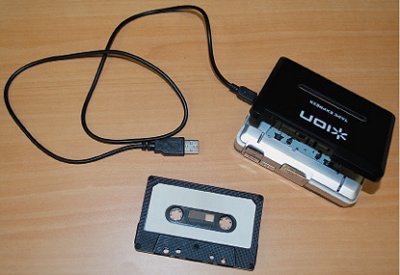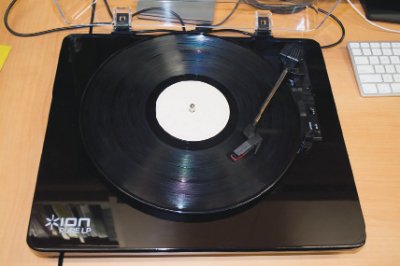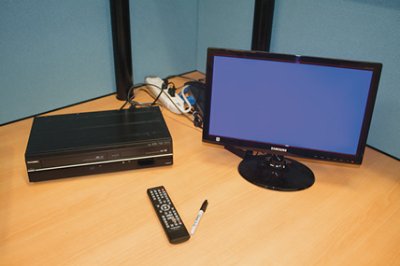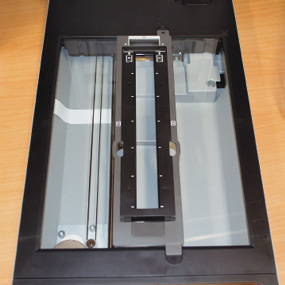FEATURE
Saving Stuff: Digital Preservation for Family Historians
by Angela Stanley and Natalie Wright
| Held over a 4-month period, the series of courses offered library patrons both lecture-based and workshop-style classes with hands-on experience. |
Twenty-first century genealogists are, broadly speaking, 20th-century adults. They may be taking smartphone pictures of their youngest family members or have grown accustomed to searching databases such as Ancestry.com and FamilySearch, but they remember a time before iPhones and the internet. In many cases, these family historians have created or inherited a mixed bag of meaningful physical and digital objects: scrapbooks, photographs, birth certificates, and videocassettes—but also JPEGs, MP3 recordings, and MPEG-4 cat videos. Thanks to the plethora of blogs, magazines, and television shows geared toward the amateur genealogist, many have also inherited a sense of pending doom and a vague notion of the importance of preservation. Some even wrestle with a newer, headier word: digitization.
With this wealth of memory and posterity, many family historians feel caught between the roles of genealogy researcher and digital archivist, but lack the technical resources to fulfill the demands of the latter position. Enter the Athens-Clarke County Public Library, the headquarters of Georgia’s Athens Regional Library System. Angela Stanley, then the head of archives and special collections, observed the need for public education in the field of what the Library of Congress (LC) has dubbed “personal digital preservation” and for individualized assistance in converting analog media to digital. In fall 2015, Stanley teamed up with her colleague Natalie Wright, head of the Athens-Clarke County Public Library’s Digital Media Center (DMC), to offer a six-course series: Saving Stuff: Preservation for the Family Historian. Here’s how the program operated, along with notes about the technologies that were employed.
Teaching Digitization Methods
Held over a 4-month period, the series of courses offered library patrons both lecture-based and workshop-style classes with hands-on experience. All sessions in the series required advanced registration, although no one was turned away. Informative handouts were provided at all classes, letting patrons know exactly what to bring—such as their original media and a flash drive or writable CD—and how much time to schedule when they returned.
The series consisted of the following six classes offered in order: Personal Digital Archiving of Audio and Video, Converting VHS to Digital, Converting Vinyl to Digital, Personal Digital Archiving of Photographs, Repairing Old Photographs With Photoshop, and Converting Cassette Tapes to Digital.
Following the workshops, patrons were invited to schedule appointments with Wright and the DMC staffers to use the library’s equipment to convert their own audiocassettes, videotapes, vinyl records, and photographs. Additionally, Stanley offered one-on-one appointment sessions for patrons to bring their digital device to the library for preservation guidance and tips.
Two classes in the series explored the basic tenets of digital stewardship: Personal Digital Archiving of Audio and Video and Personal Digital Archiving of Photographs. Both guided patrons through a condensed, five-step digital archiving process: identifying, deciding, saving and exporting, organizing, and copying and managing. The classes made frequent use of the materials freely available on the LC site (digitalpreservation.gov/personalarchiving) as well as those available from the Northeast Document Conservation Center (nedcc.org/free-resources/preserving-private-and-family-collections/caring-for-private-and-family-collections and nedcc.org/free-resources/digital-preservation) and the National Archives (archives.gov/preservation). Stanley also included simple best practices from the American Society of Media Photographers (dpbestflow.org) for file naming conventions, file and folder-level metadata, and suggestions for redundant backups.
In the classes, Stanley and Wright both discussed considerations for prioritizing digitization, including physical preservation concerns, personal significance of the item, informational value, and legal restrictions. The patrons who were happiest with their results spent their time converting rare or personal items. A recurrent theme throughout all classes was the imperative to “make it meaningful” when selecting media to convert and preserve. Many patrons were surprised to learn that although the equipment was free and easy to use, the biggest investment was time. Unfortunately, some patrons who wanted to convert their cassettes and videos quit after realizing the time commitment. These formats require real-time conversion, which is a significant investment for a 6-hour VHS tape.
Offering Hands-On Training
Wright’s classes were a series of demonstrations and workshops that introduced patrons to the conversion equipment freely available in the DMC. Certain equipment lent itself well to demonstration before a large audience, such as using the freeware software program Audacity (audacityteam.org). Other equipment and processes, such as VHS tape conversion, were better suited to individual workshop sessions.
Preserving sound files. The DMC is equipped with a $35 ION cassette player with a USB cable for converting cassette tapes. The ION player plugs directly into the computer, which recognizes it as a microphone input, and cassettes are recorded using Audacity. Patrons record a track from the cassette player input in real time and export the resulting audio. The audio can be exported in a variety of formats and, with a simple add-on, working files can be exported as either WAV files for CDs or MP3s.
The disadvantage to recording from a cassette player is that the tape hiss is also captured. In this digital age, most people are no longer accustomed to ignoring this hiss. Thankfully, Audacity has a noise reduction feature: One must simply record some part of the cassette without audio and create a sound sample from it. The sample can be used by Audacity to remove the tape hiss from the entire track. While this method provides a better finished product, it means that processing a cassette tape requires about twice the amount of time it takes to play the cassette.
To convert vinyl albums, the DMC has an ION turntable with a USB connection, which costs approximately $60. The turntable is recognized by the computer as a microphone input. It comes with software that allows for adjustment of the recording gain—how loud or soft the signal coming from the device is—and will divide the recording into tracks interpreted by the pauses between sounds.
This software generally works well, but it is easily fooled by live albums, as the applause masks the pauses. It also has difficulty interpreting audio with dynamic loud and soft sections. For example, musicals and opera recordings often contrast quieter and louder parts of a song for emphasis; the ION software assumes the track is complete when the music is quieter. To avoid this issue, Wright recommends using Audacity, which also allows the user to remove the initial sound of the needle drop. Since no noise reduction is needed, processing time is much less than that required for cassettes. A record brush and cleaner are highly recommended for records that have not been played in years, as the dust will give the recording plenty of pops that detract from the quality.
Converting videotapes. The Toshiba VHS-to-DVD converter is a standalone machine requiring a monitor or TV for use; it does not record onto a computer. At approximately $210 at the time of purchase, this equipment was among the most costly to acquire. Standard VHS tapes hold 2 hours of video; however, most camcorders have the option to record on a “long play” or “extended play” setting. This setting compresses the video signal and allows anywhere from 4 to 6 hours of content to be recorded on a single tape. A standard DVD-R holds 2 hours of video, so it is possible that patrons will need up to three discs to convert a single VHS tape. Once the content has been transferred to a DVD, ripping software on the computers can convert DVD content to editable video files. Editing software can also add captions or remove content.
VHS tapes degrade easily from exposure to heat and humidity, causing poor tracking, reduced color saturation, and static. Many tapes stored in attics or garages break during fast-forward or rewind operations. Unless the case unscrews, which is rare, there is no easy way to repair the tape.
Digitizing VHS tapes had another, unexpected side-effect: the need for a box of tissues in the DMC. Because the machine records in real time, the content that plays on the screen is exactly what is being recorded. Many were watching their family videos for the first time in 20 or more years. Seeing beloved relatives who had since passed away proved to be a very emotional experience for many patrons.
Digitizing photos and films. Scanners have been a standard piece of equipment in many libraries for years, and the DMC chose a $200 Canon 5600F with an included attachment for scanning 35mm film. A setting on the built-in software automatically recognizes and crops individual photos when several are placed on the scan bed, allowing decreased time per scan over previous models.
However, slides and film are still very time-consuming, as the scanning resolution to make full-size digital images requires anywhere from 3 to 5 minutes per image. Wright observed that the scanner took 3 minutes for a standard 3" x 4.5" print scanned at 1,200 pixels per inch and 5 minutes to scan a 15" x 22" print at 4,800 pixels per inch. The Canon 5600F can only scan four slides, or one strip of film, at a time. Again, the “make it meaningful” selection process came into play, as many patrons who intended to digitize all of their slides and negatives began to pick and choose images after their first 30 minutes of scanning.
Repairing and restoring photos. Wright’s final class offered methods for scanning and repairing damaged print photographs. The DMC freely provides Adobe Photoshop, and Wright concentrated on three simple tools to take care of most issues. Levels, a tool used to correct fading, allows the user to adjust the light tones, mid-tones, and dark tones independently in the image so the perfect balance can be achieved. Color Balance is another Photoshop tool that enables the removal of any yellow cast or discoloration present in acidic or otherwise damaged papers. Both of these tools operate with sliders, so the patron doesn’t need to know a specific value; he or she simply moves the slider until the desired result is achieved.
Lastly, the Clone tool is helpful. Many original photos have been stored improperly and have spots, tears, and bent corners. The Clone tool allows the user to lift an area from one section of the image and deposit it in another. By replacing an area of the picture with another from the same picture, the unique grain patterns and color casts match perfectly. Of course, there are limitations. There must be a matching section of the photo that is undamaged to provide a source for the tool. Walls, clothing, and even areas of skin tone are usually easy to fix. Spots or tears that go through a face are only repairable if they do not obscure the subject’s features, because there is no source to clone for a nose or an eye. Water damage is also particularly difficult because it tends to distort the entire image. Photo correction is a very slow and detail-oriented task. Depending on the level of damage, patrons took anywhere from 30 minutes to 2 hours to correct a single photo.
Results and Further Information
The goal of the Saving Stuff: Preservation for the Family Historian workshop series was to give patrons access to digital preservation best practices and equipment that might otherwise be too intimidating or expensive. Ninety-eight people attended classes or workshops in the series. By specifically reaching out to the patrons of the Heritage Room, who were generally already invested in family history, the DMC gained many users who might not otherwise have been aware of or used its resources. In follow-up surveys, many patrons expressed that they had no idea the equipment was available before the series of classes.
In June 2016, the Saving Stuff series was selected for a poster presentation at the American Library Association’s annual conference in Orlando. Positive public and professional reception to the series reinforces the need for this kind of interdepartmental approach to digital preservation. To learn more, handouts and course materials are available on the Heritage Room’s website at athenslibrary.org/athens/departments/heritage/services/classes-programs-handouts.
Hot Devices: Not Your Mother’s Genealogy Kit |
| Genealogical research used to start with sifting through dusty records, but now it may involve dusting them off so they can be digitized. Among the equipment that participants in the Saving Stuff classes got to get their hands on were these pieces of specialized digitization gear. |
 |
 |
| When plugged into a computer, this ION cassette player acts as a microphone. The incoming sound from the audiotape is captured and converted seamlessly into digital audio files that can be edited using programs such as Audacity. |
The ION turntable works the same way as the cassette player: Just dust off the record, plug the device into a computer, and play the recording. Sound editing software loaded on the computer can be used to eliminate the noise of needle drops in the resulting sound files. |
 |
 |
| This Toshiba DVD/VHS recorder, which can be used for archiving the family videotapes, is a standalone unit that only requires a monitor to use. But you may need to break up the content on one VHS tape into several DVDs. |
For digitizing family photos, slides, and 35mm films, this Canon 5600F does it all, although scanning may take a while. This model’s film attachment holds the film in the center of the bed where a light in the lid illuminates it as it is scanned. |
|